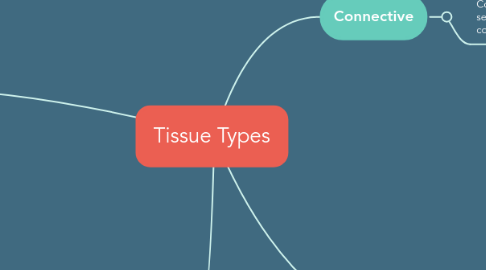
1. Muscular
1.1. Skeletal Muscle
1.1.1. Voluntary
1.1.2. Composed of striated, tubular, multinucleated fibers.
1.1.3. Attached to the skeleton by tendons.
1.2. Cardiac Muscle
1.2.1. Involuntary
1.2.2. Composed of striated, branched, uninucleated fibers.
1.2.3. Occurs in the walls of the heart.
1.2.4. Contains an intercalated disc for impulse spread between cells.
1.3. Smooth Muscle
1.3.1. Involuntary
1.3.2. Composed of spindle-shaped, nonstriated, uninucleated fibers
1.3.3. Occurs in the walls of internal organs.
2. Epithelial
2.1. This tissue forms the lining of organs, and covers the body.
2.1.1. Squamous
2.1.1.1. Flattened shape
2.1.2. Cuboidal
2.1.2.1. Cube shape
2.1.3. Columnar
2.1.3.1. Rectangular column shape
3. Connective
3.1. Connects organs together. Cells are separated by a matrix, containing collagen.
3.1.1. Loose Fibrous
3.1.1.1. Beneath the epithelial tissue, connecting it to other tissues.
3.1.1.2. Becomes a protective covering for organs.
3.1.2. Dense Fibrous
3.1.2.1. There are more collagen fibers, and they are packed tighter together.
3.1.2.2. They are found in tendons and ligaments.
3.1.3. Cartilage
3.1.3.1. Cells are separated by a flexible matrix.
3.1.4. Bone
3.1.4.1. Bone has a hard matrix made of calcium that surrounds the collagen fibers.;
3.1.5. Blood
3.1.5.1. Blood is made from multiple types of cells floating in plasma. It carries heat, oxygen, and nutrients throughout the body.
3.1.5.2. Blood helps to clot, and to fight disease.
4. Nervous
4.1. Allows the body to respond to its environment.
4.1.1. Neuron - the nerve cell
4.1.1.1. Composed of the axon, dendrites, and the cell body.
4.1.2. Neuroglia - cell that supports and nourishes the neuron
4.1.2.1. There are 9 neuroglia for every one neuron.
4.1.2.2. They form a myelin sheath to allow the nerve impulses to move faster.

